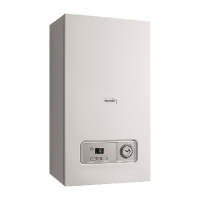0020238424_04 Betacom 4 Installation and maintenance instructions 29
9.10 Thoroughly flushing the heating installation
("hot")
1. Operate the appliance until the boiler and the heating
system are up to temperature.
2. Check the heating system for leaks.
3. Connect a hose to the drain valve located at the lowest
position of the heating system.
4. Shut off the boiler, open the drain valve and all purge
valves on the radiators and allow the water to flow out
of the heating system and the boiler quickly and fully.
5. Close the drain valve.
6. Fill the heating system again with water as described in
Filling the heating installation and Purging the heating
installation.
7. Re-fill the system until the system design pressure of
0,1 MPa (1,0 bar) is attained.
Note
The actual reading on the digital pressure
gauge should ideally be 0,05 MPa (0,5 bar)
plus an additional pressure corresponding
to the highest point of the system above the
base of the boiler – 10 m head equals an ad-
ditional 1 bar reading on the pressure gauge.
The minimum pressure should not be less
than 0,1 MPa (1 bar) in any installation. If
the system is to be treated with an inhibitor it
should be applied at this stage in accordance
with the manufacturer’s instructions
8. Install the front casing.
9.11 Checking leak-tightness
▶ Check the gas pipe, the heating circuit and the hot water
circuit for leak-tightness.
▶ Check that the air/flue pipe has been installed correctly.
Condition: Room-sealed operation
▶ Check whether the vacuum chamber has been closed
tightly.
9.11.1 Checking the heating mode
1. Activate the heating mode on the user interface.
2. Turn all thermostatic valves on the radiators until they
are fully open.
3. Allow the product to operate for at least 15 minutes.
4. Purge the heating installation.
5. Activate the display for the current operating mode.
(→ Page 24)
Status codes – Overview (→ Page 45)
◁ If the product is working correctly, the display shows
S.04.
9.11.2 Checking the domestic hot water generation
1. Activate the domestic hot water mode on the user
interface.
2. Open a hot water tap completely.
3. Activate the display for the current operating mode.
(→ Page 24)
Status codes – Overview (→ Page 45)
◁ If the product is working correctly, the display shows
S.14.
10 Adapting the unit to the installation
You can reset/change the system parameters (section "Us-
ing diagnostics codes").
Overview of diagnostics codes (→ Page 42)
10.1 Setting the burner anti-cycling time
To prevent frequent switching on and off of the burner and
thus prevent energy losses, an electronic restart lockout
is activated for a specific period each time the burner is
switched off. The burner anti-cycling time is only active for
the heating mode. Domestic hot water mode during a burner
anti-cycling time does not affect the timing element.
10.1.1 Setting the maximum burner anti-cycling
time
1. Set diagnostics code . (→ Page 24)
Overview of diagnostics codes (→ Page 42)
2. If required, change the maximum burner anti-cycling
time using the diagnostics code d.02.
10.1.2 Resetting the remaining burner anti-cycling
time
▶ Hold the button down for more than 3 seconds.
◁ is shown in the display.
10.2 Setting the pump output
The product is equipped with a speed-regulated high-effi-
ciency pump, which adjusts independently to the hydraulic
conditions of the heating installation.
If the heating installation is equipped with a low loss header,
switch off the speed control and set the pump output to a
fixed value.
Condition: Modulating pump
▶ If required, change the setting of the pump speed, which
depends on the operating mode, under diagnostics code
d.14.
Overview of diagnostics codes (→ Page 42)

